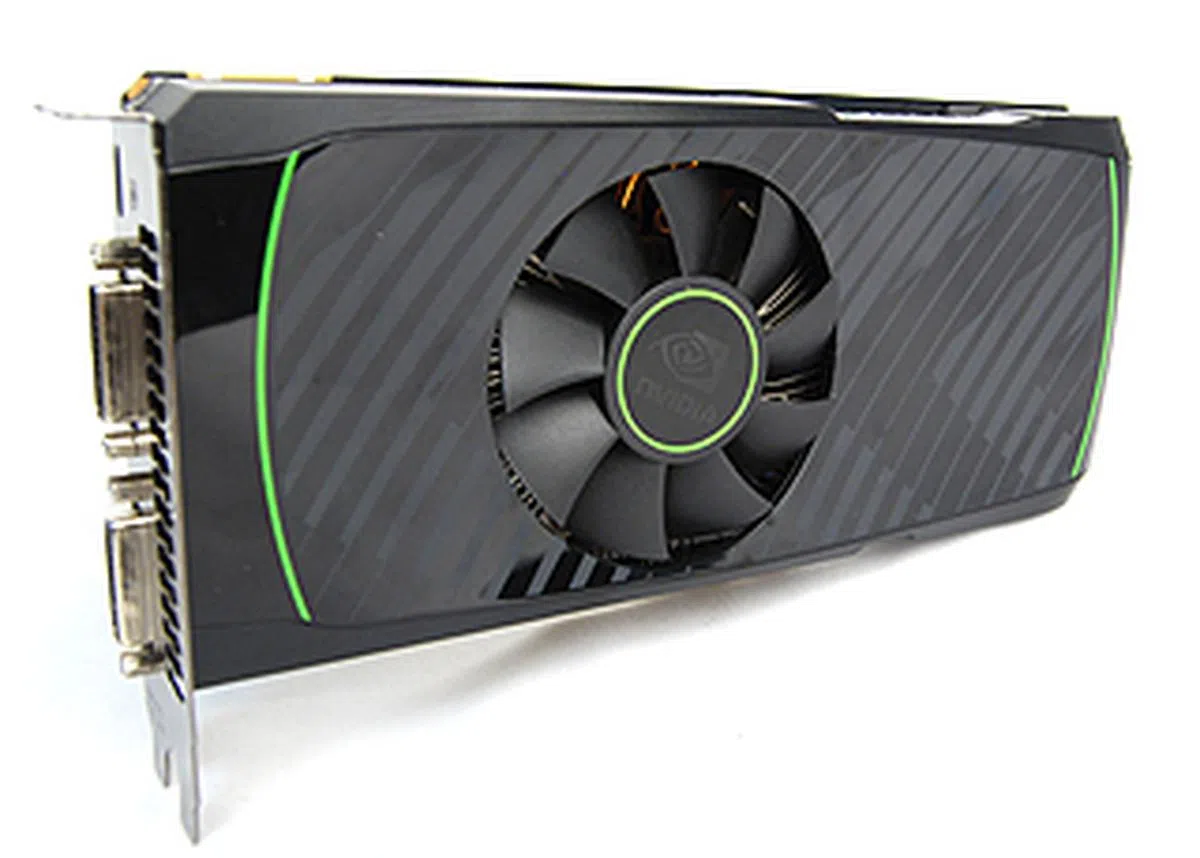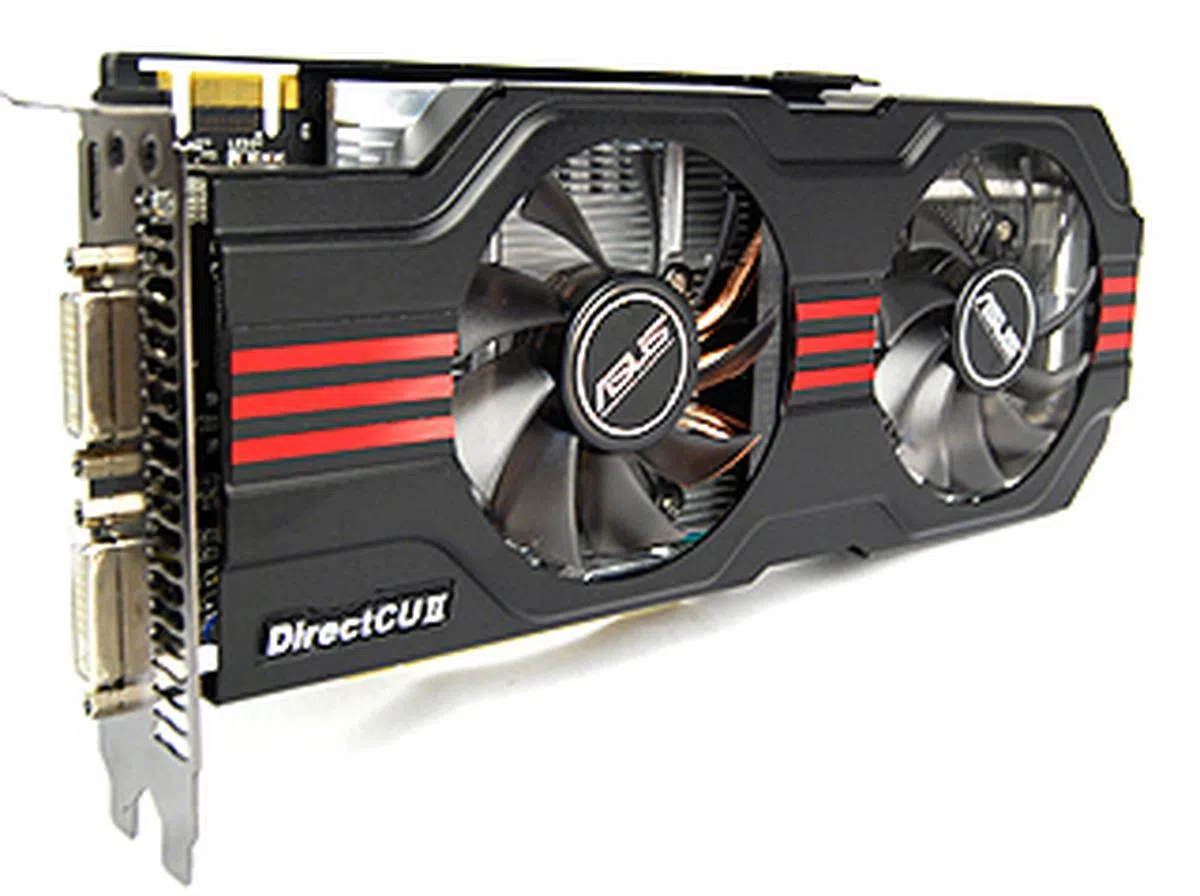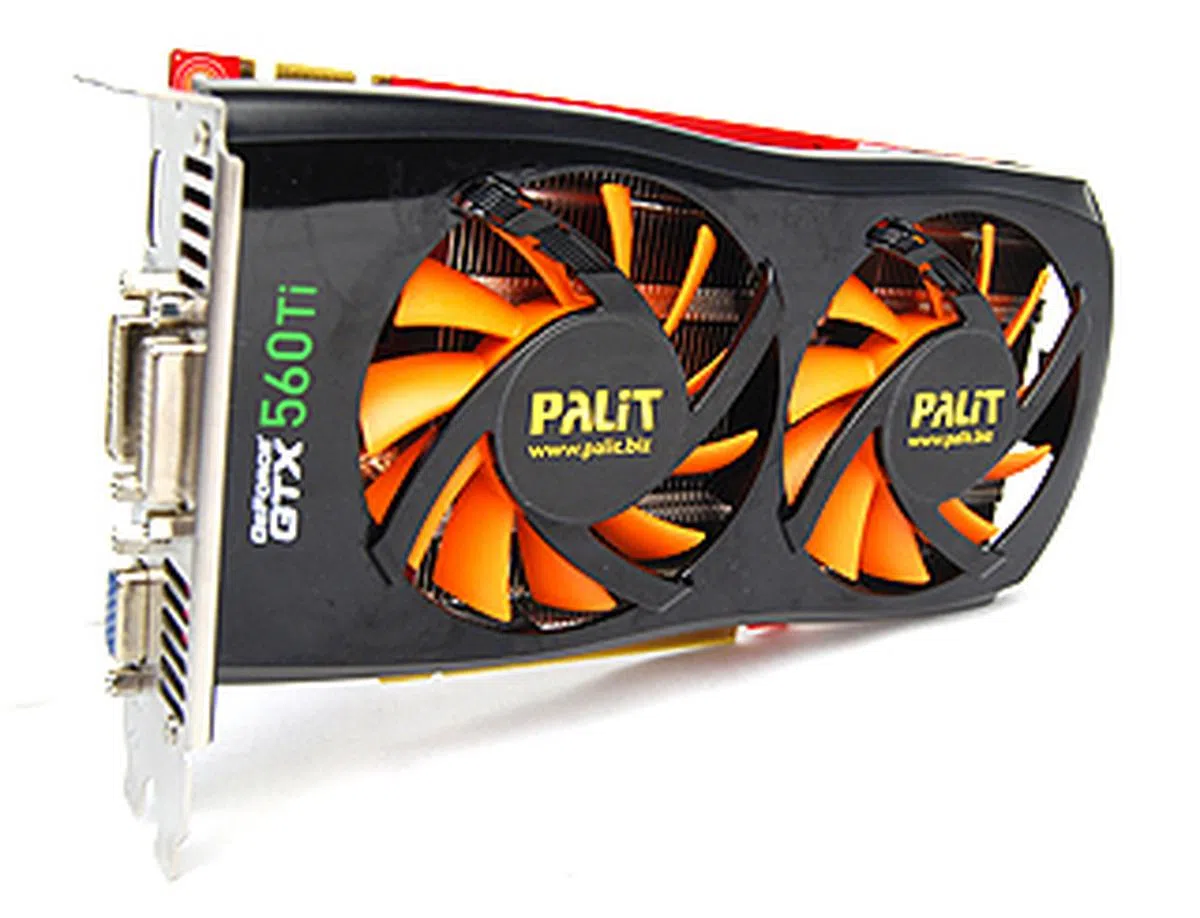NVIDIA GeForce GTX 560 Ti - A New Titan Rises
NVIDIA has a new card for the new year and it is called the GeForce GTX 560 Ti. Packing 384 CUDA cores and various transistor-level improvements and tweaks, it replaces the older GeForce GTX 470 in NVIDIA's line-up. We check out the reference card along with two custom ones from ASUS and Palit to see just how good it is.
By Kenny Yeo -
New Card for a New Year
2010 was a topsy-turvy year for NVIDIA. In March last year, they finally introduced the first of their long-awaited Fermi cards in the form of the , and later the . And although the two cards were blazing fast, they were extremely power-hungry and also very hot to run. But in July and with the launch of the GeForce GTX 460, things turned for the better. As we noted in our review, the was one of the best offerings from NVIDIA for quite some time and was, back then at least, the best bang for buck mainstream card one could buy.
Since then, NVIDIA has gradually improved on their offerings. The flagship , introduced in November last year, not only cemented NVIDIA’s hold on the title of world’s fastest single GPU card, but also features a host of improvements such as a tweaked core and a specially-designed custom vapor chamber cooler for better power efficiency and thermal characteristics. This was then followed up by the , essentially a more efficient and cooler GeForce GTX 480.
However, NVIDIA’s arch-rivals, AMD, is not one to keep quiet and stand still. In October last year, they released the first of their Radeon HD 6000 series (codenamed Northern Islands) cards, beginning with the mainstream . This was then followed up by the high-end . Although the new cards from AMD isn’t a major step forward for the company, they are more efficient and do offer a notable improvement in performance.

A new card for the new year, this is the GeForce GTX 560 Ti. Its architectural configuration is similar to the GeForce GTX 460, but it boasts more hardware parts, and is poised to replace the GeForce GTX 470. Confusing? Read on to find out if this card can deliver a fatal blow to its competitor.
Now, it’s a new year, and NVIDIA is taking the first swipe by launching the much anticipated GeForce GTX 560 Ti. Yes, the fabled “Ti”, Titanium, moniker is back, and for good reason, because this card packs significantly more hardware compared to the older GeForce GTX 460. For starters, the GeForce GTX 560 Ti follows the same SM (streaming multiprocessor) configuration as the GeForce GTX 460 so it has eight Polymorph engines and a grand total of 384 CUDA cores - that’s 48 cores and one Polymorph engine more than the older GeForce GTX 460.
And on top of the increase core count, it also has significantly higher clock speeds, 822MHz at the core, 1644MHz at the shaders, and 4008MHz DDR at the memory; compared to the GeForce GTX 460’s 675MHz at the core, 1350MHz at the shaders, and 3600MHz DDR. All in, NVIDIA claims that the GeForce GTX 560 Ti is about 30% quicker than the old GTX 460.
Performance aside, NVIDIA has also incorporated the same transistor level changes that were first implemented on the GeForce GTX 580, and later the GTX 570, to improve the GeForce GTX 560 Ti’s power efficiency. Despite being based on the GeForce GTX 460, NVIDIA claims that the improvements made to the GeForce GTX 560 Ti is enough for it to make it a suitable replacement for the GeForce GTX 470. So far, the GeForce GTX 560 Ti sounds very promising, so let’s delve deeper and find out how it actually performs in the following pages.
Model | NVIDIAGeForce GTX 560 Ti | NVIDIAGeForce GTX 460 | NVIDIA GeForce
GTX470 | NVIDIAGeForce
GTX570 | AMDRadeon HD 6870 | AMDRadeon HD6850 | ATI Radeon HD 5850 |
Core Code | - | GF104 | GF100 | GF110 | Barts XT | Barts PRO | Cypress Pro |
Transistor Count | 1950 million | 1950 million | 3200 million | 3000 million | 1700 million | 1700 million | 2150 million |
Manufacturing Process | 40nm | 40nm | 40nm | 40nm | 40nm | 40nm | 40nm |
Core Clock | 822MHz | 675MHz | 607MHz | 732MHz | 900MHz | 775MHz | 725MHz |
Stream Processors | 384 Stream Processors | 336 Stream Processors | 448 Stream Processors | 480 Stream Processors | 1120 Stream processing units | 960 Stream processing units | 1440 Stream processing units |
Stream Processor Clock | 1644MHz | 1350MHz | 1215MHz | 1464MHz | 900MHz | 775MHz | 725MHz |
Texture Mapping Units (TMU) or Texture Filtering (TF) units | 64 | 56 | 56 | 60 | 56 | 48 | 72 |
Raster Operator units (ROP) | 32 | 24 | 40 | 40 | 32 | 32 | 32 |
Memory Clock | 4008MHz GDDR5 | 3600MHz GDDR5 | 3348MHz GDDR5 | 3800MHz GDDR5 | 4200MHz GDDR5 | 4000MHz GDDR5 | 4000MHz GDDR5 |
DDR Memory Bus | 256-bit | 192 / 256-bit | 320-bit | 320-bit | 256-bit | 256-bit | 256-bit |
Memory Bandwidth | 128GB/s | 86.4 / 115.2GB/s | 133.9GB/s | 152GB/s | 134.4GB/s | 128GB/s | 128GB/s |
PCI Express Interface | PCIe ver 2.0 x16 | PCIe ver 2.0 x16 | PCIe ver 2.0 x16 | PCIe ver 2.0 x16 | PCIe ver 2.0 x16 | PCIe ver 2.0 x16 | PCIe ver 2.0 x16 |
Molex Power Connectors | 2 x 6-pin | 2 x 6-pin | 2 x 6-pin | 2 x 6-pin | 2 x 6-pin | 1 x 6-pin | 2 x 6-pin |
Multi GPU Technology | SLI | SLI | SLI | SLI | CrossFireX | CrossFireX | CrossFireX |
DVI Output Support | 2 x Dual-Link | 2 x Dual-Link | 2 x Dual-Link | 2 x Dual-Link | 1 x Single-Link, 1 x Dual-Link | 1 x Single-Link, 1 x Dual-Link | 2 x Dual-Link |
HDMI | 1 (mini-HDMI) | 1 (mini-HDMI) | 1 (mini-HDMI) | 1 (mini-HDMI) | 1 | 1 | 1 |
DisplayPort | None | None | None | None | 2 (DisplayPort 1.2) | 1 (DisplayPort 1.2) | 1 |
HDCP Output Support | Yes | Yes | Yes | Yes | Yes | Yes | Yes |
Street Price | Launch price: US$249 | ~US$209 | ~US$259 | ~US$359 | ~US$239 | ~US$189 | ~US$220 |
The NVIDIA GeForce GTX 560 Ti 1GB GDDR5
From the outset, the new GeForce GTX 560 Ti looks remarkably similar to the older GeForce GTX 460, except that it is a tad longer. It uses the same cooler as the one seen on the GeForce GTX 460, but with a few enhancements. It gets a larger heatsink and an additional copper heat pipe to draw heat even more quickly away from the GPU core. Since it is a reference card, it also sports reference clock speeds, which means 822MHz at the core, 1644MHz at the shaders and 4008MHz at the memory.

The GeForce GTX 560 Ti is slightly longer, perhaps due to the upgraded 4-phase power circuitry, improved memory modules and the same power monitoring hardware that we first saw on the GeForce GTX 580 and GTX 570.

The card still gets the usual twin DVI ports and single mini-HDMI port for video output.

Power is fed through two 6-pin PCIe power connectors and the rated TDP of the GeForce GTX 560 Ti is 170W, 10W greater than the GTX 460. NVIDIA recommends a PSU rated for at least 500W to run the card safely.

Unlike the GeForce GTX 470 which it is supposed to replace, the new GeForce GTX 560 Ti gets only a single SLI connector, which means only 2-way SLI is possible.
The ASUS ENGTX560 Ti DCII TOP
As its name implies, the this card is packing ASUS’ new DirectCU II technology cooler, which has twin cooling fans, and flattened copper heat pipes which are in direct contact with the GPU core for quicker heat dissipation. The card also comes with ASUS’ new Super Alloy Power suite of enhanced components, such as Super Alloy Capacitors for a higher voltage threshold and improved overclocking potential.
To top things off, the card is also factory overclocked at a heady 900MHz at the core, 1800MHz at the shaders and 4200MHz DDR at the memory, which should make it run faster than NVIDIA's reference one.

Thanks to the massive DirectCU II cooler, the ASUS card is longer than NVIDIA's reference design.

The ASUS card gets the usual twin DVI ports and single mini-HDMI port for video output.

ASUS’ DirectCU coolers have performed well in the past and it'll be interesting to see how this new and improved DirectCU design with dual cooling fans will do in our test.
The Palit GeForce GTX 560 Ti Sonic
Admirably, Palit has given us a custom edition GeForce GTX 560 Ti on the day of launch and this is the Palit GeForce GTX 560 Ti Sonic. As its name implies, it is factory overclocked at 900MHz at the core, 1800MHz at the shaders, and 4200MHz DDR at the memory - similar to the ASUS card above. Faster clock speeds aside, it is also slightly more compact, and yet it sports a dual-fan cooler, which should help keep the card running cool.

The Palit card is slightly more compact, thanks to its redesigned custom PCB layout.

Palit has also improved on the video output options, giving users twin DVI ports, a VGA port and also a full-sized HDMI port.

Apart from the two cooler fans, the card also has a copper heatsink core which dissipates heat quickly to the two aluminum heatsink arrays.
Test Setup
We will be evaluating the new GeForce GTX 560 Ti using our X58 test system which has the following specifications:
- Intel Core i7-975 (3.33GHz)
- Gigabyte GA-EX58-UD4P motherboard
- 3 x 1GB DDR3-1333 OCZ memory in triple channel mode
- Seagate 7200.10 200GB SATA hard drive
- Windows 7 Ultimate
Judging from paper specifications, we fully expect the GeForce GTX 560 Ti to outperform the older GTX 460, thanks to its superior number of CUDA cores and higher clock speeds. The question is, how much? And since it is set to replace the GeForce GTX 470, it’ll be interesting to see how the cards matches up as well. Also, we’ve also included results from other mainstream to high-end cards such as the GeForce GTX 570, AMD Radeon HD 6870, HD 6850, and even the old HD 5850.
As for the two custom cards, we’re expecting it to perform appreciably better than the reference card from NVIDIA, thanks to their boosted clock speeds. And considering they have similar clock speeds, we expect them to be very competitive where raw framerate counts are concerned, however, it will be interesting to see how they perform in terms of cooling efficiency and overclockability.
Here's a quick look at the three cards clock speeds:
Cards | Core Clock Speed | Shader Clock Speed | Memory Clock Speed |
NVIDIAGeForceGTX560 Ti | 822MHz | 1644MHz | 4008MHz DDR |
ASUSENGTX560 Ti DCIITOP | 900MHz | 1800MHz | 4200MHz DDR |
Palit GeForce GTX 560 Ti Sonic | 900MHz | 1800MHz | 4200MHz DDR |
The full list of cards tested and driver versions used:
- NVIDIA GeForce GTX 560 (ForceWare 266.56 )
- ASUS ENGTX560 Ti DirectCU II TOP (ForceWare 266.56)
- Palit GeForce GTX 560 Ti Sonic (ForceWare 266.56)
- NVIDIA GeForce GTX 460 (ForceWare 263.09)
- NVIDIA GeForce GTX 470 (ForceWare 263.09)
- NVIDIA GeForce GTX 570 (ForceWare 263.09)
- AMD Radeon HD 6870 (Catalyst 10.12)
- AMD Radeon HD 6850 (Catalyst 10.12)
- AMD Radeon HD 5850 (Catalyst 10.9)
The full list of benchmarks used:
- Futuremark 3DMark Vantage
- Futuremark 3DMark 11
- Crysis Warhead
- Far Cry 2
- Warhammer: Dawn of War 2
- Battlefield Bad Company 2
- Hawx 2
- “Heaven" from Unigine v2.1
- S.T.A.L.K.E.R.: Call of Pripyat
3DMark 11 and 3DMark Vantage Results
The NVIDIA GeForce GTX 560 Ti got off to a good start on 3DMark Vantage, easily outscoring the all the cards from the red camps by a good 15% at least. It also scored appreciably higher than thee GeForce GTX 460 and GTX 470, by about 30% and 15% respectively, which is certainly impressive.
And expectedly, the two custom GeForce GTX 560 Ti cards from ASUS and Palit scored even higher, thanks to their boosted clock speeds. They also managed comparable scores, which we had anticipated given their identical clock speeds.

3DMark 11 is the latest benchmarking utility from Futuremark and it makes extensive use of all of DirectX 11’s features such as tessellation, compute shaders and DirectCompute. Here, the GeForce GTX 560 Ti found itself trailing slightly against the Radeon HD 6870, but the margin was very slight, with the Radeon HD 6870 by only about a 100 or so 3DMarks. And again, we noted that the two custom cards from ASUS and Palit were able to attain significantly higher scores, that were about 7% greater than that of the reference card’s.

Crysis Warhead & Far Cry 2 Results
The GeForce GTX 560 Ti performed well on Crysis Warhead, easing past the Radeon HD 6870. However, we noted that while the GeForce GTX 560 Ti had a substantial lead on the lower resolutions of 1280 x 800 and 1650 x 1050, the Radeon HD 6870 clawed itself back into the game when we reach 1920 x 1200. Nevertheless, it was still about a good 4% to 5% quicker overall. It was also considerably quicker than the GeForce GTX 460 and GTX 470.
Again, the two custom design GeForce GTX 560 Ti cards were faster than the reference card from NVIDIA. And considering their identical clock speeds, it wasn’t surprisingly to see that their results are almost duplicates of each other. On average, the two custom cards were about 7% quicker than NVIDIA’s reference design.


NVIDIA cards have traditionally performed well on Far Cry 2 benchmarking and the GeForce GTX 560 Ti showed no signs of letting up as seen below. Against the Radeon HD 6870, it was about a whopping 20% faster, and compared against the older GeForce cards, it was more than 20% quicker than the GeForce GTX 460, and about 10% faster than the GeForce GTX 470. It was no match for the 480-core GeForce GTX 570 though, but it wasn’t that far off.
Unsurprisingly, because of their higher clock speeds, the two custom GeForce GTX 560 Ti cards were once more quicker than the reference card, by about 7%. And again, bearing in mind their similar clock speeds, they posted nearly identical results.


Dawn of War 2 Results
Dawn of War 2 has often been a tightly contested affair and it was no different here, as we only noticed significant differences in performance on the highest resolution of 1920 x 1200. Here, the GeForce GTX 560 Ti maintains its superiority over the older GeForce GTX 460 and GTX 470, but it lost out against the Radeon HD 6870 by about 7%.
The custom ASUS and Palit cards were quicker than the reference card and because of their carbon copy clock speeds, recorded very comparable results.

Battlefield Bad Company 2 Results
Bad Company 2 is a fairly intensive DirectX 11 title, but the GeForce GTX 560 Ti managed well, putting it very playable frame rates. It was a good 30% quicker than the GeForce GTX 460, but was a smidge slower when compared to the GeForce GTX 470. Our guess is that the GeForce GTX 560 Ti’s smaller 1GB framebuffer (compared to the GTX 470’s 1280MB framebuffer) proved to be its undoing. That said, it is appreciably faster than its targeted rival, the Radeon HD 6870, by around 8% overall.
The two custom cards maintained a a good 7% lead over the reference card and also maintained consistently similar scores.

Hawx 2 Results
Hawx 2 is one of the new games that we are introducing and it extensive use of tessellation to create extremely life-like environments. Against the Radeon HD 6870, the new GeForce GTX 560 Ti was miles ahead, and was more than 30% quicker. It was also a good deal quicker than the GeForce GTX 460 too - by roughly 27%.
Expectedly the two custom design, factory overclocked cards were quicker than the reference one - by about 8% - and considering the two cards have identical clock speeds, they also recorded identical results.

Unigine "Heaven" 2.1 Results
Unigine’s “Heaven” benchmark is tessellation heavy, and here we see the GeForce GTX 560 Ti performing admirably. With tessellation enabled, it was marginally quicker than the GeForce GTX 470 and more than 30% quicker overall than the GTX 460. Against the Radeon HD 6870, the GeForce GTX 560 Ti was around a massive 40% quicker with tessellation enabled. When we disabled tessellation, the Radeon HD 6870 managed to reduce the lead, but even so, the GeForce GTX 560 Ti remained noticeably faster.
The custom-designed ASUS and Palit continued to post quicker frame rates than the reference card and again their frame rates were very similar to one another, which is not surprising considering they have identical clock speeds.
DirectX 11 Results


DirectX 10 Results


S.T.A.L.K.E.R.: Call of Pripyat Results
On the Day Run with tessellation enabled, the new GeForce GTX 560 Ti performed well, matching the GeForce GTX 470 and outpacing the GeForce GTX 460 by more than 30% overall. It also easily dispatched the Radeon HD 6870, especially when anti-aliasing was enabled. This was the same on the Sun Shafts run with tessellation enabled, as the GeForce GTX 560 Ti put in yet again an impressive performance, outpacing both the GeForce GTX 460 and its intended rival, the Radeon HD 6870, by about 40% overall. On the other hand, we noticed that the Radeons managed to close the gap slightly when we disabled tessellation and reverted to running the benchmark using DirectX 10. This is something we have noted in our reviews of previous Fermi cards and which evidently shows that the Fermi architecture is better suited for tackling DirectX 11 applications.
As for the two custom GeForce GTX 560 Ti cards from ASUS and Palit, they continued to be marginally quicker than the reference card and between the two, they also continued to rack up identical frame rates. Based on raw performance alone, it is impossible to distinguish the two cards.
DirectX 11 Results
 |  |
 | 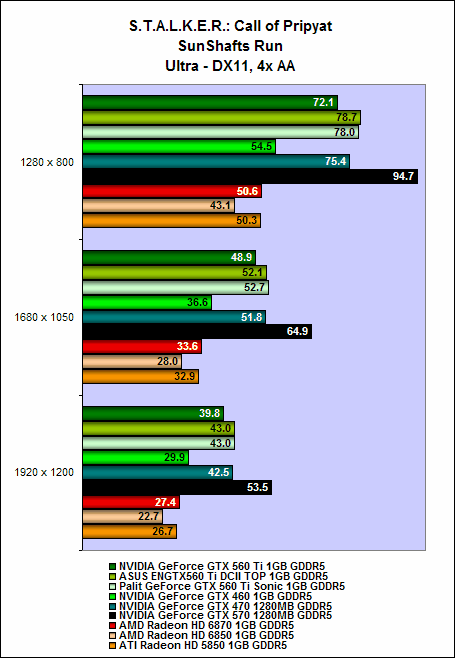 |
DirectX 10 Results
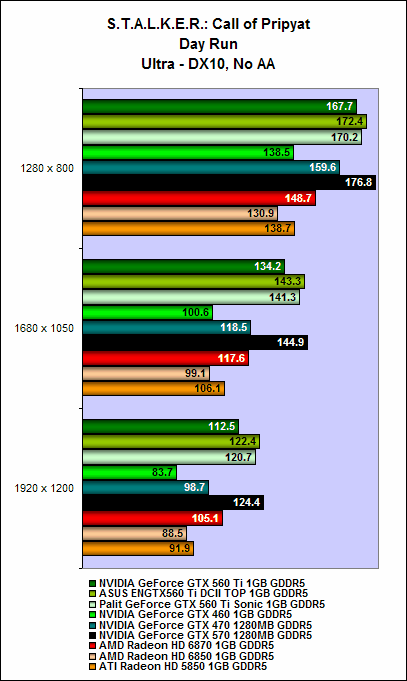 | 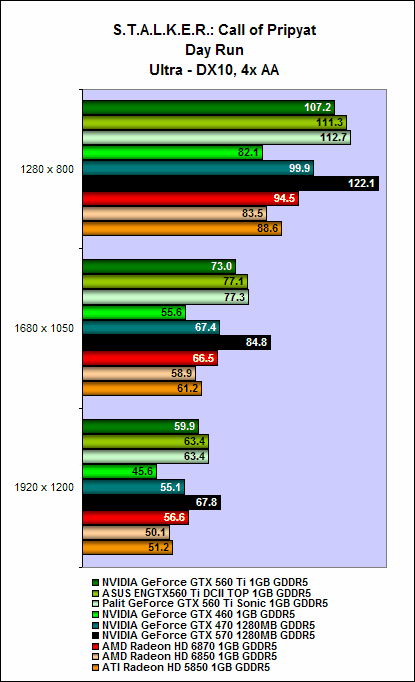 |
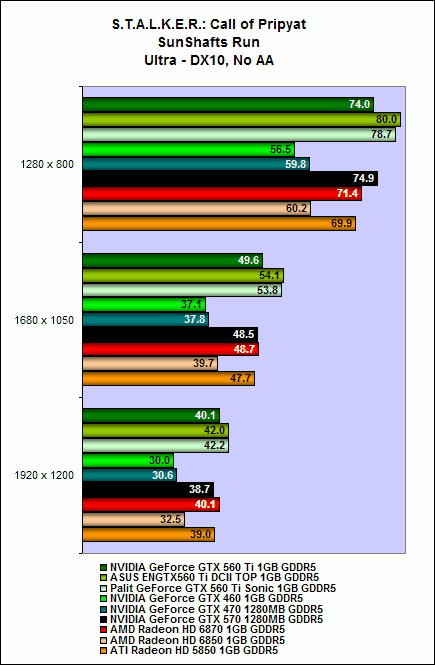 | 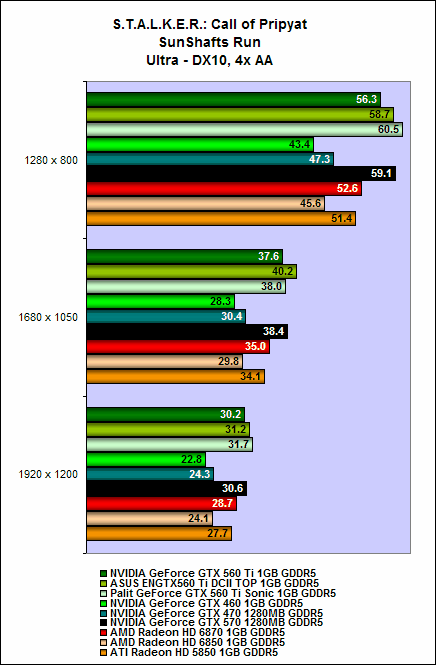 |
Temperature
In our test, we found that the reference card recorded a peak operating temp of 70 degrees Celsius, which is actually impressive considering its extra hardware and fairly high clock speeds. Comparatively, the GeForce GTX 460 ran at 67 degrees Celsius, only a smidge cooler, and the GeForce GTX 470 came in at a toasty 94 degrees Celsius.
As for the two custom cards, the ASUS card and its DirectCU II cooler worked well, helping the card record a breezy 60 degrees Celsius. As for the Palit card, that was a bit disappointing because despite having a dual-fan cooler, it still recorded 70 degrees Celsius. And considering both the ASUS and Palit cards have identical clock speeds, it just goes to show how much more effective ASUS’ custom cooler is. The catch is that you'll have to take into consideration of a bigger card from ASUS, while the Palit is a much more compact card with better performance than the reference card and is no warmer than it.

Power Consumption
If there’s one thing that we didn’t like about the new GeFore GTX 560 Ti was its rather high power requirements. NVIDIA has made good progress in reducing the power requirements of their Fermi cards beginning with the GeForce GTX 460, and we’ve seen massive improvements too in the GeForce GTX 580 and GTX 570. But looking at the figures we’ve recorded here, it seems that NVIDIA has taken one step back. Idle power readings are encouraging, but at load, we recorded a maximum sustained reading of a hefty 272W, which is considerable higher than the GeForce GTX 460 and comparable with the old GeForce GTX 470 and GTX 580.
Although the two factory overclocked cards recorded comparable idle power draw readings, at load, they fared a little worse, as we recorded figures that weren’t too far off against the GeForce GTX 570. Beginning with the GeForce GTX 460, NVIDIA has made great improvements to keep power requirements modest, but if figures here are anything to go by, it seems that they have dropped the ball a little with the GeForce GTX 560 Ti. Perhaps in a bid to appease the raw performance orientated crowd, they traded power for performance, which is something most folks building new PCs can afford to spare - generally speaking.

Overclocking
NVIDIA claims the GeForce GTX 560 Ti was built with overclockers in mind, and to that end, they have included a 4-phase power circuitry, faster 5Gbps memory modules, an additional copper heat pipe and enlarged heatsink and cooling fan. Well, we’re pleased to say that their efforts have paid off as we managed a respectable 960MHz at the core and 4500MHz DDR at the memory, giving us 10719 3DMarks - an improvement of 1298 3DMarks or 13%.
The two custom GeForce GTX 560 Ti cards from ASUS and Palit did competitively well in our overclocking tests too. The ASUS card managed a maximum overclocking state of 950MHz at the core and 4600MHz DDR at the memory, attaining 10756 3DMarks in the process - an improvement of 5%. On the other hand, the Palit card recorded a lower core clock speed of 940MHz, but managed a higher memory clock speed of 4900Mhz DDR, resulting in 10852 3DMarks.

New Year Offensive
The new year has started with NVIDIA building on the momentum of the earlier released GeForce GTX 580 and GTX 570. All things considered, the new GeForce GTX 560 Ti is an accomplished card, offering substantial improvements over the older GeForce GTX 460 and the model it replaces, the GeForce GTX 470.
From a pure performance standpoint, the GeForce GTX 560 Ti is a mainstream to high-end powerhouse. It’s still some ways off compared to the 480-core GeForce GTX 570, but it was a good 30% quicker than the GeForce GTX 460 and it mostly matches or outperforms the GeForce GTX 470. Against its intended competitor from AMD, the Radeon HD 6870, it completely outclassed it as it was mostly faster by anywhere from 5% to as much as 30%. Hence, where raw performance is concerned, the GeForce GTX 560 Ti is very difficult to fault.
We must also commend it for its cooling performance, because despite the additional hardware and considerably higher clock speeds, the reference GeForce GTX 560 Ti card was only a tad warmer than the older GeForce GTX 460 and much cooler than the GeForce GTX 470. Overclocking performance was also pretty impressive as we managed to achieve a 13% boost in performance on a reference GeForce GTX 560 Ti.
The only downer was the GeForce GTX 560 Ti’s higher than expected power draw figures. NVIDIA claims a TDP of only 10W higher than that of the GeForce GTX 460, so we would naturally expect power usage to be just a little more. However from our actual test findings, the power draw of the GeForce GTX 560 Ti is more comparable with that of the GeForce GTX 570. It’s early days yet, and the unusually high power draw figures could be due to issues with the drivers. We’ll be keeping a close eye on developments in the weeks ahead and will update our findings accordingly. But from our experience, what we've reported is perhaps the final standings as driver revisions seldom fix these aspects no matter how hard you cross your fingers.

High power consumption figures aside, we fully expect the GeForce GTX 560 Ti to be a great hit, considering the performance it offers for its price.
As a replacement to the GeForce GTX 470, the new GeForce GTX 560 Ti has been given a launch price of US$249 by NVIDIA. Considering most Radeon HD 6870 cards are retailing around US$239, the GeForce GTX 560 Ti is a very, very attractive proposition, because for US$10 more, you are getting a card that is much more powerful. Furthermore, the GeForce GTX 470 is presently retailing for around US$259, so in essence, NVIDIA has given us an improved card at a lower price. In fact, the way we see it, despite having the added bonus of EyeFinity, there’s absolutely no way the Radeon HD 6870 could hope to compete against the GeForce GTX 560 Ti, mainly because the gulf in performance is simply too wide. As it is, the Radeon HD 6870 will find it very difficult to compete with the GeForce GTX 560 Ti in this price bracket, and we fully expect AMD to announce changes in their pricing strategy soon.
On a whole, the GeForce GTX 560 Ti is an extremely compelling offering from NVIDIA. For its price, it offers blazing fast performance, outstanding overclocking potential, and runs reasonably cool at load. Our only misgiving is that its power consumption figure was on the high side.
Elsewhere, the two custom-designed cards from ASUS and Palit are commendable efforts from both companies. It’s impossible to separate the two based on raw performance, but overall, the ASUS card has a slight advantage because of its much more efficient cooler. That said, the Palit card isn’t too shabby, considering it managed to maintain operating temperatures at a reasonable level, in spite of its boosted clock speeds. As for pricing, the Palit GeForce GTX 560 Ti Sonic will command a US$10 premium over reference cards, bringing its price to US$259, which we think is quite good value for money considering the performance it offers. And although ASUS couldn't provide us with global pricing at the time of publish, we can expect it to cost a US$10 to US$20 premium over reference cards too.
|  |
|  |
Our articles may contain affiliate links. If you buy through these links, we may earn a small commission.
